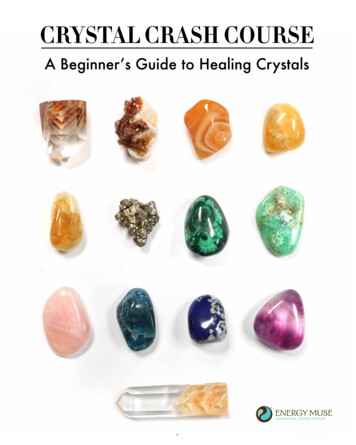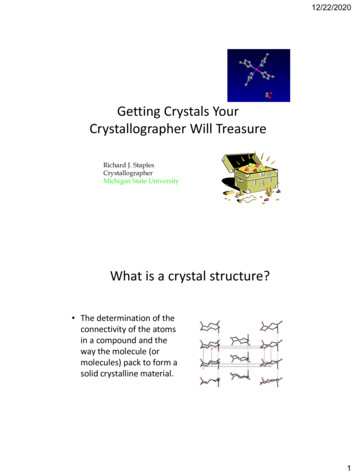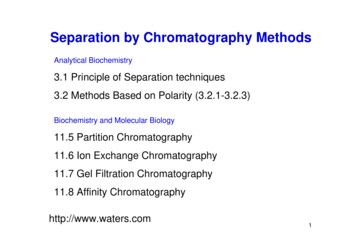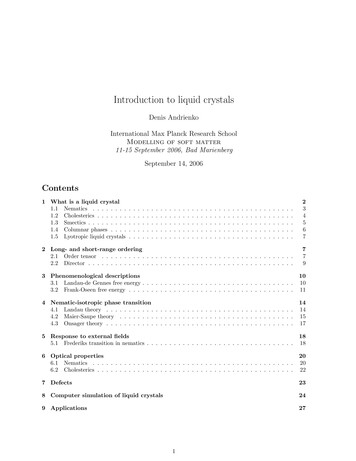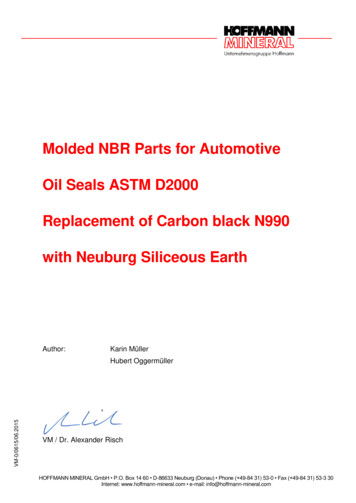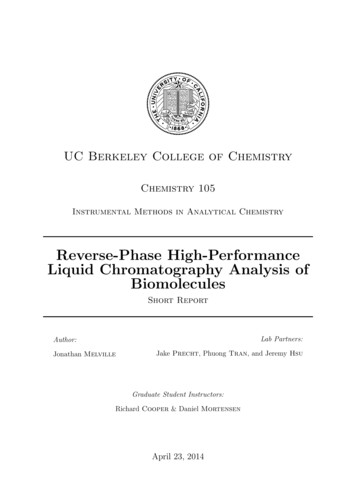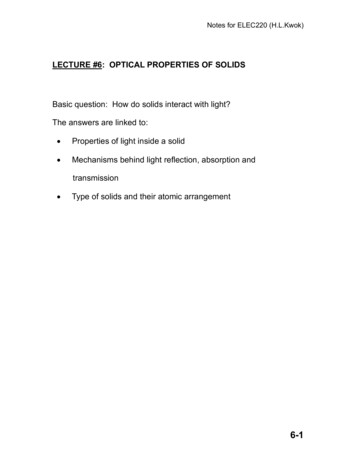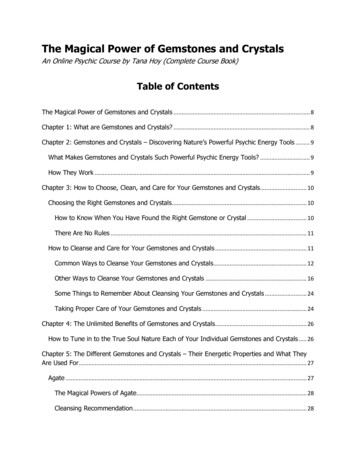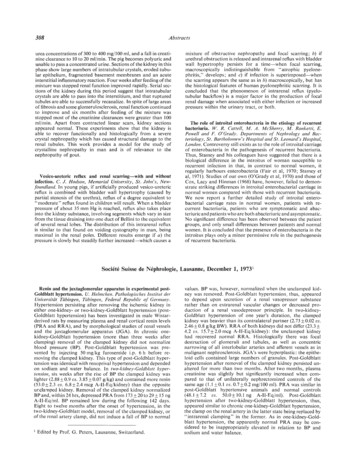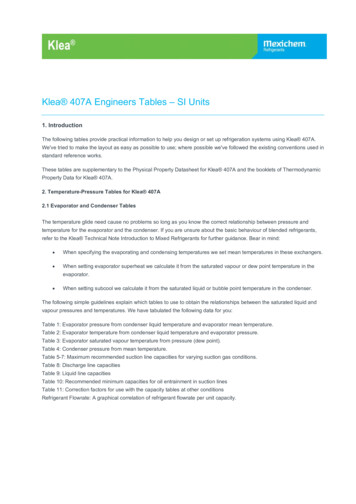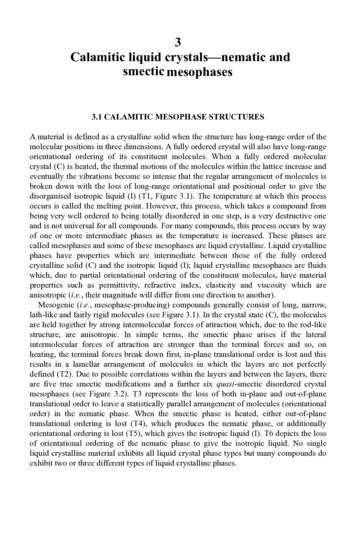
Transcription
3Calamitic liquid crystals—nematic andsmectic mesophases3.1 CALAMITIC MESOPHASE STRUCTURESA material is defined as a crystalline solid when the structure has long-range order of themolecular positions in three dimensions. A fully ordered crystal will also have long-rangeorientational ordering of its constituent molecules. When a fully ordered molecularcrystal (C) is heated, the thermal motions of the molecules within the lattice increase andeventually the vibrations become so intense that the regular arrangement of molecules isbroken down with the loss of long-range orientational and positional order to give thedisorganised isotropic liquid (I) (T1, Figure 3.1). The temperature at which this processoccurs is called the melting point. However, this process, which takes a compound frombeing very well ordered to being totally disordered in one step, is a very destructive oneand is not universal for all compounds. For many compounds, this process occurs by wayof one or more intermediate phases as the temperature is increased. These phases arecalled mesophases and some of these mesophases are liquid crystalline. Liquid crystallinephases have properties which are intermediate between those of the fully orderedcrystalline solid (C) and the isotropic liquid (I); liquid crystalline mesophases are fluidswhich, due to partial orientational ordering of the constituent molecules, have materialproperties such as permittivity, refractive index, elasticity and viscosity which areanisotropic (i.e., their magnitude will differ from one direction to another).Mesogenic (i.e., mesophase-producing) compounds generally consist of long, narrow,lath-like and fairly rigid molecules (see Figure 3.1). In the crystal state (C), the moleculesare held together by strong intermolecular forces of attraction which, due to the rod-likestructure, are anisotropic. In simple terms, the smectic phase arises if the lateralintermolecular forces of attraction are stronger than the terminal forces and so, onheating, the terminal forces break down first, in-plane translational order is lost and thisresults in a lamellar arrangement of molecules in which the layers are not perfectlydefined (T2). Due to possible correlations within the layers and between the layers, thereare five true smectic modifications and a further six quasi-smectic disordered crystalmesophases (see Figure 3.2). T3 represents the loss of both in-plane and out-of-planetranslational order to leave a statistically parallel arrangement of molecules (orientationalorder) in the nematic phase. When the smectic phase is heated, either out-of-planetranslational ordering is lost (T4), which produces the nematic phase, or additionallyorientational ordering is lost (T5), which gives the isotropic liquid (I). T6 depicts the lossof orientational ordering of the nematic phase to give the isotropic liquid. No singleliquid crystalline material exhibits all liquid crystal phase types but many compounds doexhibit two or three different types of liquid crystalline phases.
44â Introduction to Liquid CrystalsFigure 3.1. Possible melting sequences for a liquid crystallinematerial.Liquid crystal phases can be identified by their individual birefringent textures when viewedbetween crossed polarisers under a light microscope (see Chapter 9). Such studies by Friedel in1922 led to the nematic phase (nematic is Greek for thread-like) being so named because itsoptical texture appeared as a series of optically extinct threads (defects) on a coloured(birefringent) background. A nematic liquid crystal phase can be generated by both calamiticmolecules (long and lath-like structures) and discotic molecules (disc-like structures, seeChapter 4); however, although both variations exhibit the same optical texture, these twonematic phases are not miscible and hence are not the same. Friedel did not recognise theexistence of more than one smectic phase but he noticed that the ‘smectic phase’ had a soaplike appearance and hence was named because smectic is Greek for soap-like. Additionally,chiral variations of the nematic and smectic phases exist and these will be discussed in Chapter6. Figure 3.1 sufficiently illustrates the molecular orientational order of the nematic (N)phase. In an isotropic liquid (properties are identical regardless of the direction in whichthey are measured), the constituent molecules are completely disordered with respect to eachother; however, they do not possess enough thermal energy to break into the gas phase. Inthe nematic phase the constituent molecules are also completely disordered with respect to eachother but the long molecular axes statistically point in a preferred direction known as thedirector ( ). This one degree of ordering of the nematic phase makes it the least orderedliquid crystal phase with a high degree of fluidity. This fluidity combined with theanisotropic nature of the molecules is the basis for the operation of liquid crystal displays.
Calamitic Liquid Crystals—Nematic and Smectic Mesophasesâ 45The fluid nematic phase has a low viscosity and nematic materials can be designed sothat molecular orientation can be switched by an electric field; the different opticalproperties of the two orientations enables display applications (see Chapter 13).Figure 3.2. Plan views of smectic mesophase structures.The smectic mesophase is more ordered than the nematic phase and furthermore, whereasonly one nematic phase exists, the ‘smectic phase’ exhibits polymorphism (see Figure3.2); i.e., there are many different types of smectic phases. As for the nematic phase, thesmectic phases can be identified by optical polarising microscopy (see Chapter 9). In1917, Grandjean was studying (by microscopy) a sample of smectic liquid crystal (laterclassified as smectic A) which showed stepped edges, indicating that the smectic phasewas lamellar in nature. The lamellar nature of smectic phase allows various combinationsof molecular correlations both within the ‘layers’ and between the ‘layers’, each of whichconstitutes a different type of smectic mesophase.
46â Introduction to Liquid CrystalsInitially smectic phases can be subdivided into the true liquid crystal smectics and theeven more ordered crystal smectics. The crystal smectics have no liquidity and arecrystals (the molecules possess long-range positional order in three dimensions);however, there is considerable disorder of molecular orientation and so they aremesophases but not liquid crystal phases. The true smectic liquid crystals areconsiderably less ordered and are liquids. A second crucial subdivision of smectic phasesis made depending upon whether the constituent molecules are tilted, or not, with respectto the layer normal. Figure 3.2 shows idealised plan views of the molecular organisationwithin the different smectic mesophases. The constituent molecules of the smectic A (SA)are not tilted and they have no positional ordering within the layers. The smectic C (SC)phase is the tilted analogue of the SA phase. The smectic B (SB) phase is more orderedthan the SA phase with the constituent molecules adopting a hexagonal ordering (bondorientational ordering) but the hexagonal lattices only have a repeat positional order over 150–600 Å. The hexagonal nature of the SB phase generates two tilted analogues calledthe smectic I (SI) phase and the smectic F (SF) phase where the molecules are tilted suchthat the hexagonal lattice tilts towards the apex and the side, respectively (the tiltdirection is depicted by the direction of the ‘triangular’ molecules in Figure 3.2). In the crystalB (B) phase the molecules are also hexagonally ordered but additionally the positions ofthe hexagonal lattices are predictable over a long range in three dimensions. The crystal E(E) phase develops from a contraction of the hexagonal lattice which confers a herringbone-like structure with restricted rotation. The crystal J (J) and the crystal G (G) phasesare tilted analogues of the B phase and the crystal K (K) and the crystal H (H) phases arethe respective tilted analogues of the E phase; the tilt direction is shown by the arrows.3.2 STRUCTURE-PROPERTY RELATIONSThis chapter considers the molecular structure of rod-like (calamitic) liquid crystalmaterials and how those structures can be tailored to generate specific liquid crystalphases at specific temperatures. An enormous number of liquid crystal materials has nowbeen prepared and although many are very similar, each has its own specific combinationof structural moieties which confer a certain phase morphology and particular values ofmelting point and transition temperatures. Additionally, the combination of structuralmoieties determine the physical properties of materials which are very important whenmaterials are being considered for specific applications. Accordingly, much care isrequired in the design and synthesis of liquid crystal materials in order to generate thedesired liquid crystal properties and the necessary general physical properties.When account is taken of the phenomenal number of organic compounds that havebeen prepared, and can possibly be prepared, then only a very small proportion of thistotal will exhibit any liquid crystal phases. The generation of liquid crystal phases islimited by both steric and polarity considerations, i.e., liquid crystal phases can only beexhibited by materials of specific molecular structures. To be suitable for an application,not only does a material require the necessary molecular structure to generate a desiredliquid crystal phase at the required temperature over a specific temperature range, but amaterial also needs to possess a suitable combination of physical properties for that
Calamitic Liquid Crystals—Nematic and Smectic Mesophasesâ 47application. Of course, not all liquid crystal materials are suitable for applications or infact even designed as such. Much valuable information on the structure-propertyrelationships of liquid crystals has been provided by fundamental, ‘blue-sky’ research.Subsequently this knowledge has been applied to the design and synthesis of liquidcrystal materials that are used in the rapidly growing range of applications that are ofincreasing importance to the technological advancement (see Chapter 13).All scientists working in the field of liquid crystals, be they chemists, physicists,mathematicians, engineers, theoreticians or biologists, require at least a basicunderstanding of the structure-property relationships of liquid crystal materials. Not onlyis such an understanding essential, it is well recognised that structure-propertyrelationships of liquid crystals are an extremely interesting aspect of the liquid crystalfield, although perhaps not as interesting as actually synthesising and evaluating thematerials!The nematic (N) liquid crystal phase is technologically the most important of the manydifferent types of liquid crystal phases (discussed later). The nematic phase is the liquidcrystal phase that is used in virtually all commercially available liquid crystal displays(see Chapter 13). The World market for liquid crystal displays continues to expandstrongly and is currently worth 8 billion per year which accounts for a large proportionof all displays. Nematic liquid crystal displays are expected to satisfy future demand formedium-sized displays (perhaps screen sizes of several centimetres to about 30centimetres). On the other hand the smectic liquid crystal phases (there are severaldifferent types, see later) have found very little commercially successful applications.However, as will be seen later, a display that employs the chiral smectic C liquid crystalphase (the ferroelectric display) is expected to become commercially successful in thecoming years. Such displays offer extremely fast switching and are expected to satisfydemand for small displays of very high resolution and for fast-switching light valves (seeChapter 13). Accordingly, the structure-property relations of liquid crystalline materialsare extremely important.Many questions now need answering, such as what type of structural units andcombinations of structural units allow the generation of the nematic phase? How do thesediffer from those required to generate smectic phases? How do structural features varyfrom one type of smectic phase to another? What structural features are responsible forthe generation of a smectic phase where the constituent molecules are tilted (e.g., SC)?How do structural features affect the physical properties of liquid crystal materials? Whatpredictive powers does the synthetic chemist have to enable the accurate synthesis of amaterial with desired properties?Before attempting to answer these important questions and discussing in detail how themolecular structure and combinations of structural units affect the generation of thevarious mesophase types and physical properties, some general introductory points areworthy of inclusion.Figure 3.3. A general structural template for calamiticliquid crystals.
48â Introduction to Liquid CrystalsFigure 3.3 shows a general template that can be used to describe the structure of calamiticliquid crystal materials, including those that exhibit the nematic phase and smecticphases. A and B are the core units which are sometimes linked by a linking group (Y) butmore often a direct link is used. Similarly, the terminal chains (R and R') can be linked tothe core with groups X and Z but usually the terminal chains are directly linked to the core.Lateral substituents (M and N) are often used to modify the mesophase morphology andthe physical properties of liquid crystals to generate enhanced properties for applications.The units that are used in this general structure and their combinations determine the typeof liquid crystal phase (if any) and the physical properties exhibited by a compound. Acertain rigidity is required to provide the anisotropic molecular structure; this core of thestructure is usually provided by linearly linked ring systems (A and B) that are most oftenaromatic (e.g., 1,4-phenyl, 2,5-pyrimidinyl, 2,6-naphthyl) but can also be alicyclic (e.g.,trans-1,4-cyclohexyl). The rings can be directly linked or they may be joined by a linkinggroup (Y) which maintains the linearity and polarisability anisotropy (*,) of the core (e.g.,). The rigid core alone is not usually sufficient to generateliquid crystal phases and a certain flexibility is required to ensure reasonably low melting points and to stabilise the molecular alignment within the mesophase structure.The flexibility is provided by the terminal substituents R and R' which are usually straightalkyl or alkoxy chains; however, one terminal unit is often a small polar substituent (e.g.,CN, F, NCS, NO2). Occasionally, the terminal chains are branched and the branching unitcan be non-polar (e.g., CH3) or polar (e.g., CN, F, CF3); normally this design feature isused to introduce chirality into the molecules, which is discussed in Chapter 6. Althoughgenerally detrimental to the formation of liquid crystal phases, lateral substituents are often necessary to tailor physical properties to a particular application. Many different typesof lateral substituents have been used (e.g., F, Cl, CN, CH3); however, the fluoro substituent isthe most useful because of its subtle combination of small size and high electronegativity.Gradually, throughout this chapter, we will discuss in detail the types of structural featuresthat enable the generation of the nematic liquid crystal phase and those that enable the generationof smectic phases; a greater emphasis will be placed on the nematic phase because of its greattechnological importance. It is a fact that many liquid crystal materials exhibit both the nematicphase and the smectic phase (often more than one). Accordingly, many structural features cansupport both types of liquid crystal phases which causes difficulty in generalisation. However,one common generalisation is that the generation of the nematic phase is facilitated by theuse of relatively short terminal chains (longer ones tend to stabilise the lamellar arrangement of molecules) in conjunction with a core of high longitudinal polarisability, which isachieved by keeping the core short and/or using conjugative linking groups. Experience hasrevealed that the relative efficiency of nematic phase generation by terminal units isIn general, similar structural features can be used to generate all types of smecticmesophase, although the SA phase is by far the most common smectic phase exhibited
Calamitic Liquid Crystals—Nematic and Smectic Mesophasesâ 49(probably because it is the most disordered smectic phase). Additionally, special polarstructural requirements are necessary to generate tilted smectic phases, of which the SCphase is by far the most common, again probably because of the high degree of disorder.Often the more ordered smectic phases are difficult to identify and are often simply listedas S or SX. This lack of full classification probably reflects the minor importance ofordered smectic phases. No one single material exhibits all smectic mesophases, althoughsome come quite close. Many materials exhibit several different smectic phases and manysmectic materials also exhibit the nematic phase at higher temperatures.The smectic phases are lamellar in structure and more ordered than the nematic phase.Accordingly the molecular structure required to generate a smectic phase must allow forlateral intermolecular attractions. Hence the smectic phases are favoured by asymmetrical molecular structure; thus many molecules with a wholly aromatic core orwholly alicyclic core each with two terminal alkyl/alkoxy chains compatible with thecore tend to pack well into a layer-like structure and generate smectic phases. Anybreaking of the symmetry or where the core is long relative to the overall molecularlength tends to destabilise smectic formation and facilitate the formation of the nematicphase. Additionally, the use of lateral substituents tends to disrupt the lamellar packingwhich destabilises the smectic phases and thus can allow the generation of the nematicphase. In fact any broadening of the core unit (e.g., by using a 2,6-disubstitutednaphthalene core unit) will disrupt lamellar packing and favour the nematic phase. So thenematic phase is certainly what is left over if the structural conditions are not sufficientlyoptimised for the generation of the more ordered smectic phases.Many compounds are known to exhibit the nematic phase; the immense technologicalimportance of the nematic phase and academic interest have both driven the design andsynthesis of a wide range of nematic materials. Some of these materials (e.g., compound1) are nematogens, i.e., the nematic phase is the only mesophase exhibited; othercompounds (e.g., compound 2) exhibit the nematic phase at temperatures above those forwhich smectic mesophases are also exhibited; similarly many compounds aresmectogenic. Accordingly, the structures of materials that exhibit the calamitic (nematicand smectic) liquid crystal phases are extremely varied and of all the differentmesophases, the nematic liquid crystal phase is the most commonly exhibited. However,the general, basic structural requirements of the nematic phase, and in fact other types ofliquid crystal phases, can be shown by a general template (Figure 3.3).The synthesis of a great number of materials that exhibit the nematic phase hasachieved many different goals. Firstly, much knowledge has been acquired of the effectof structural features and various combinations of structural features on melting points,mesophase morphology, and stability. Secondly, many physical properties have beenevaluated for a great number of nematic liquid crystals and the results have been linked tothe structure. Thirdly, mixtures of nematic materials have been formulated that have been
50â Introduction to Liquid Crystalsevaluated for their suitability for applications (e.g., display devices). Overall, manynematic materials have been prepared that are highly suitable for their intendedapplications and a wealth of information exists that enables more accurate research intonew and improved materials. The synthesis of liquid crystal materials is discussed inChapter 8.The mesomorphic properties and physical properties of nematic (and smectic)materials and ultimately their suitability for applications are all fundamentally dictated bythe chemical structure of the constituent molecules. Before progressing further, severalterms and their definitions need to be clarified; this will be done by using the nematicphase. The term nematic phase stability refers to the upper-temperature limit (TN-I) towhich the nematic phase exists and the term nematic range means the temperature rangeover which the nematic phase exists. The tendency of many materials to supercool beforethey recrystallise enables the nematic phase to be exhibited as a metastable state belowthe melting point and where the nematic phase stability is below the melting point thephase is termed monotropic. Conversely, where the nematic phase stability is higher thanthe melting point the phase is termed enantiotropic.For example, compounds 1, 3 and 4 are well-known nematogenic materials that are usedin liquid crystal displays. Compound 1 melts at 24.0 C and has a nematic phase stabilityof 35.0 C which gives a nematic range of 11 C, and accordingly the phase isenantiotropic. On the other hand, compound 3 melts to an isotropic liquid at 48.0 C andthe nematic phase forms on supercooling the liquid and has a phase stability of 16.5 C;consequently there is no enantiotropic nematic range and the phase is monotropic.Finally, compound 4 melts at a relatively high temperature and does not supercoolsufficiently to allow a nematic phase to be generated. Accordingly a ‘nematic phasestability’ was determined by formulating mixtures with a host material of known nematicphase stability and extrapolating the TN-I values back to 100% of compound 4. Liquidcrystal phases are often denoted in a standard format with monotropic phases given inround brackets and virtual, extrapolated phases given in square brackets. Structureproperty relationships of calamitic liquid crystal materials will now be discussed in detailwith an emphasis on the nematic phase.3.2.1 Core structuresPerhaps the most fundamental structural feature of a liquid crystal material is theso-called core. The core can, in fact, be difficult to define absolutely, but it is usuallydefined as the rigid unit which is constructed from linearly linked ring units; the core isoften defined to include any linking groups and any lateral substituents that are connectedto the rings (see later).
Calamitic Liquid Crystals—Nematic and Smectic Mesophasesâ 51Figure 3.4. Selected aromatic core units.Most calamitic liquid crystals possess aromatic rings (Figure 3.4), usually 1,4-phenylbecause of the relative ease of synthesis (see Chapter 8) but 2,5-pyrimidine and2,6-naphthalene are also common.Figure 3.5. Selected alicyclic core units.Accordingly, it was a long held theory that the nematic phase, for example, was generatedbecause of the anisotropy of the polarisability resulting from the conjugated core unit andthat the higher the polarisability anisotropy the higher the nematic phase stability (TN-I).However, the nematic phase, like the smectic phase, is generated by many alicyclicmaterials where the cores are constructed solely of alicyclic rings (Figure 3.5). Hence, therelationship between polarisability and liquid crystal phase stability is not so clear cut.Based on the above comments, what type of core combinations give a nematic liquidcrystal phase? A vast number of core combinations generate the nematic phase either ontheir own or in combination with one or more smectic phases. Accordingly, it is difficultto generalise as to which types of cores generate the nematic phase or a particular smecticphase, but as this chapter progresses using carefully chosen comparative examples, thetrends should become reasonably clear. The nematic phase tends to be the phase exhibitedwhen the conditions for lamellar packing (i.e., the smectic phase) cannot be met, so if themolecular structure is conducive towards liquid crystal phase formation but there is somestructural feature that prevents the molecules from packing in a layer-like arrangement,then the nematic phase is likely to be generated. The nematic phase tends to be favouredwhen the terminal chains are short. In many cases the same core can be used to generatedifferent types of smectic phases in addition to the generation of the nematic phase, and
52â Introduction to Liquid Crystalsso for a given core structure (including any lateral substituent) it is very often the terminalchains (see later) that dictate the type (smectic or nematic) of liquid crystal phaseexhibited; in some cases both the smectic and the nematic phase are exhibited.Usually, at least two rings are required to enable the generation of liquid crystal phases;however, compound 5 is a rare example of an acyclic nematogen. Hydrogen bonding isresponsible for giving an elongated unit with a rigid central core and two flexibleterminal chains. A central ring is generated by intermolecular hydrogen bonding and thislinear rigid unit is significantly extended by the two trans-substituted alkenic units atboth sides of the mesogen. Accordingly, the core of compound 5 consists of the centralring and both of the conjugated di-alkenic units. The flexible terminal chains, in this case,are both saturated hexyl units. Compound 6 is again another remarkable example ofliquid crystal phase generation. The actual molecular species is certainly not long andlath-like and would not be expected to exhibit mesomorphism; however, dimerisationthrough hydrogen bonding creates a long lath-like structure with a three-ring core andtwo flexible terminal pentyl chains. So why do these materials (5 and 6) solely exhibit thenematic phase and not a smectic phase as well as or indeed in place of a nematic phase?To exhibit a smectic mesophase the molecules must have sufficient lateral attractions toenable packing within the constraints of layers stabilised by long terminal chains thatintertwine. There are many reasons why this type of packing might not be possible, forexample, the terminal chains may be short relative to the length of the rigid core.Molecular shape often creates steric problems for lateral attractions; the presence of polargroups often causes repulsion but polarity is often necessary to generate smectic phasesbecause the dipole-dipole interactions stabilise the lamellar packing arrangement of themolecules. These are some of the problems when trying to rationalise how the structureof a liquid crystal compound relates to its phase behaviour; however, there is a pattern,but it just happens to be made up of a wide range of often conflicting issues. Compound 5does have a rather small central core with much narrower peripheral additions to the core,so the steric bulk in the centre of the core creates too much free space to stabilise lamellarpacking and hence smectic phases are not generated. Compound 6 has the same centralcore but the rest of the core is more comparable in size and might therefore be morelikely than compound 5 to exhibit a smectic phase. However, the melting point is ratherhigh which could be masking any smectic phase formation. The lamellar packing isstabilised by longer terminal chains; compound 7 has two long terminal alkoxy chainsand exhibits a smectic C (SC) phase to a high temperature. Typically, as the terminalchains become longer (compound 8) the smectic phase stability increases further and thenematic phase stability is reduced.
Calamitic Liquid Crystals—Nematic and Smectic Mesophasesâ 53The alkylcyanobiphenyls (e.g., compounds 9) were invented in 1972 by Gray andco-workers at the University of Hull. These materials were the first commercially viablenematic liquid crystals for use in display devices. The materials combine low meltingpoints with reasonably high TN-I values and Table 3.1 shows the transition temperaturesoften alkylcyanobiphenyl homologues.Table 3.1. Transition temperatures for alkylcyanobiphenyl homologues.CompoundNo.RCTransition Temperatures ( C)SANI9aCH3 109.0—[ 45.0] 9bC2H5 75.0—[ 22.0] 9cC3H7 66.0—( 25.5) 9dC4H9 48.0—( 16.5) 9eC5H11 24.0— 35.0 9fC6H13 14.5— 29.0 9gC7H15 30.0— 43.0 9hC8H17 21.5 33.5 40.5 9iC9H19 42.0 48.0 49.5 9jC10H21 44.0 50.5— The aromatic core in conjugation with a terminal cyano group confers a positivedielectric anisotropy and a reasonably high optical anisotropy (birefringence). They havea reasonably low viscosity and more importantly, they are chemically andphotochemically stable. These materials are still successfully used in simple watch andcalculator type displays (twisted nematic display devices) and are worthy candidates fordiscussion. The core here is the 4,4'-disubstituted biphenyl unit which does not normallyconfer high liquid crystal phase stability. Accordingly, for such a small molecular lengththese materials exhibit high TN-I values. It has been suggested that the high TN-I valuesare due to the antiparallel correlations that exist and in effect enhance the true molecular
54â Introduction to Liquid Crystalslength; however, the reason may simply be the high position of the terminal cyano groupin the nematic efficiency order (see page 49). All ten compounds of Table 3.1 have thesame core yet the transition temperatures vary considerably with the length of theterminal chains (discussed later). Those compounds with the long alkyl chain lengthsexhibit the SA phase in addition to the nematic phase. In the case of compound 9j thealkyl chain length is sufficiently long to generate a particularly high value of the SA phasestability so the nematic phase is not exhibited. Many other te
Liquid crystal phases can be identified by their individual birefringent textures when viewed between crossed polarisers under a light microscope (see Chapter 9). Such studies by Friedel in 1922 led to the nematic phase (nem
